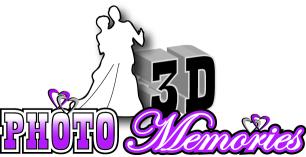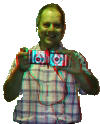This business is no longer operating.
The web site exists only for historical purposes.
3D cameras that Andrew has used
1980 - Instamatic
I was 17 years old when I first took a few 3D slides by taking one photo, then moving the camera 6 centimetres to the right and taking another photo. This is known as the "Cha Cha" method.
The novelty soon wore off because of the limitation of taking only stationary objects.
Not long after this, I bought a second Instamatic camera, drilled a couple of holes in a piece of wood, and placed the two cameras side by side. This relied on the trigger fingers from each hand pressing the shutter at the same time, and surprisingly it worked most of the time.
But the image quality was poor because the cameras where just very cheap point-and-shoot cameras, known at that time by the Kodak brand name Instamatic.
Mid 1980s - Stereo Realist
After showing some of my 3D slides to an older relative whose own father had taken 3D slides at the start of the 20th century, I was encouraged to find a better quality camera than the cheap Instamatics.
From a shop called Photantiques, which at that time was in Paddington in Sydney, I bought a Stereo Realist 3D camera. The camera was built in the 1950s, but it worked well, and produced high quality stereo slides for many years until 2003 when the camera started playing up.
2003 - Nikon D75 twin-rig
After contemplating the repair of the Stereo Realist, I decided that I was tired of being stuck with "Portrait" oriented images, as produced by the Realist, and opted instead for two new Nikon D75 SLR cameras.
This produced some very high quality slides, but I was unable to take close-ups because the physical width of each camera meant that the distance between images was about 12 centimetres.
Also, one of the reasons for wanting the Nikon SLR was that it would allow me to use automatic settings or override them if desired. The problem was that if auto-focus was on, the cameras would trigger at a different time no matter what. But with focus set to manual, the infra-red remote would always trigger the two cameras together.
2004 - Canon EOS 3000N SLR with a Loreo 3D Lens In A Cap
Being more and more frustrated by the limitations of such a wide separation of the Nikon cameras, I bought a Canon EOS 3000N SLR film camera plus a Loreo 3D Lens In A Cap.
This made 3D simple and reliable, but the compromise was both the lower quality afforded by the Loreo lens, and the return to "Portrait" oriented images, because the way the Loreo lens works is to split a standard sized 35 millimetre image in half.
2008 - Canon A570IS Digital Cameras with SDM software
My foray into 3D digital photography was with a pair of Canon A570IS. Stereo Data Maker software was used to synchronise the cameras, and Stereo Photo Maker was used to combine the left and right images to make 3D photos.
2009 - FujiFilm FinePix REAL 3D W1
2009 saw the introduction of the 10 megapixel dedicated 3D camera from FujiFilm, and I was one of the first in Australia to own one.
And for the first time, consumers could see 3D images without having to wear special glasses using the accompanying FinePix REAL 3D V1 digital viewer.
2015 - FujiFilm FinePix REAL 3D W1
From 2015 to the present, I've been using the FujiFilm FinePix REAL 3D W3, the update to the W1.
2011 - JVC Everio GS-TD1
From 2011 until the present, I've been using the JVC to record high definition 1080i 3D video, bringing the action to life. Files play back natively on most 3D televisions.

